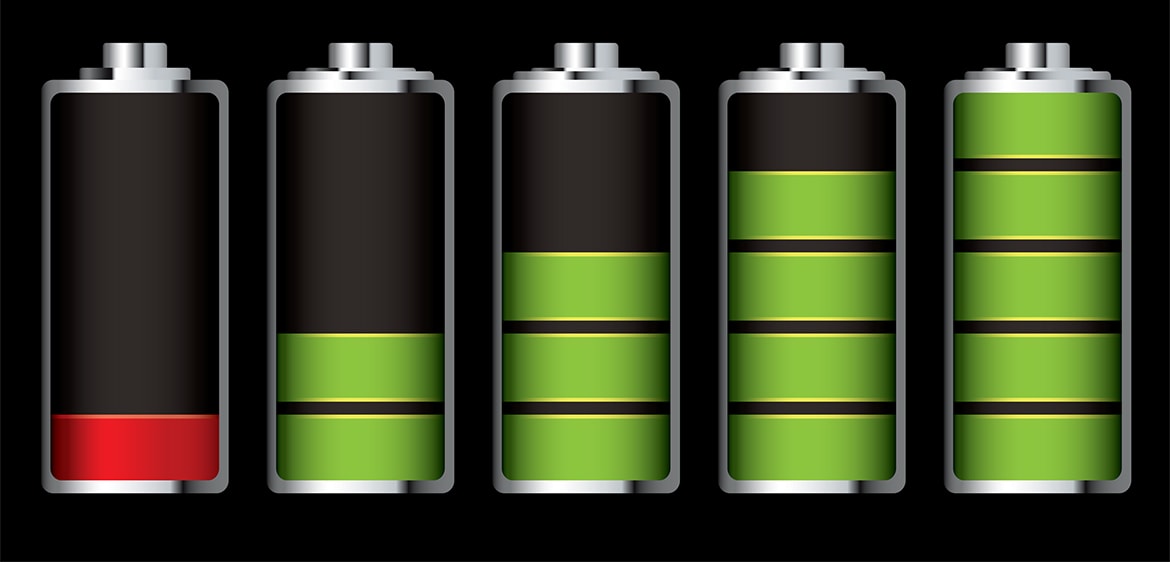The right battery for the job
There is a wide range of battery types, and each comes in a variety of shapes, sizes and configurations. Every battery type has its unique strengths and shortcomings and there is no one ideal battery for every occasion. Different battery technologies have been developed that optimize certain parameters (sometimes at the expense of others) to suit a particular usage. Like all else in engineering, battery design is a compromise.
Generally, the energy output of a battery is only related to its size and material composition. Different battery designs and manufacturing methods leads to only minor differences in the batteries’ electrical output. As a result of industry standardization, batteries of the same type, size and composition from different manufacturers are interchangeable. However, minor differences do exist and it is not advisable to mix batteries from different manufacturers in a single multi-cell application. In such use, the batteries in the set may not share the load equally, resulting in a slight reduction of the overall useful life of the batteries. Never use different types of batteries (eg. alkaline and NiCd batteries) together in a multi-cell device, even if you can use either type by themselves in the device.
Battery properties
There are some “given” parameters when selecting a battery for a particular device, such as the size, shape and voltage output. Within these parameters, there are some additional properties to be considered when choosing a battery for your application:
- Primary or Secondary – Primary batteries are not rechargeable and are appropriate for applications where infrequent, high energy output is required. Secondary batteries are rechargeable and are most appropriate for use in devices with steady periods of use and non-use (eg. pagers, cell phones).
- Capacity – defines the maximum amount of energy stored in the battery. Capacity is dependent on the material composition of the battery and the amount of material in it (type and size).
- Power output – the maximum rate at which the energy stored within the battery can be discharged. Batteries with the same voltage rating and capacity may discharge at different rates – one capable of delivering a high current if required (eg. for a cordless power tool) while another more suited for delivering a low current spread over a long period (eg. for a digital clock). High power equipment will require high power output batteries, and this is often specified by the manufacturer of the equipment.
- Cycle Life – applies to secondary batteries and defines how many times the battery may be discharged and recharged before it becomes unusable.
- Shelf life – the length of time the new, unused battery can be stored without losing a significant amount of its power.
- Physical conditions – covers the physical treatment (or mistreatment) the battery is likely to be subjected to in normal use. For example, extreme high or low temperatures, physical impact, shock or vibration.
- Cost – always an important parameter and is a function of the cost of the materials and manufacturing process of a battery. Cost is also dependent on the size of the market – high demand promotes a high degree of competition among manufacturers, creates economy of scale and generally lowers cost. It is also important to consider the total cost of using the battery over time, not just the initial purchase price, especially when considering rechargeable batteries.
- Environmental concerns – in particular, whether or not the battery uses toxic chemicals such as lead, cadmium or mercury. The environmental impact can be mitigated to some extent if there are facilities in your locality to reclaim and recycle the toxic components in discarded batteries. However, there may be some additional costs involved in doing this.
- Safety – battery components vary from inert to mildly corrosive to highly toxic or flammable. Safety requirements vary from battery use in childrens’ toys to industrial situations. The more hazardous components will require additional handling procedures.
Battery Types and Characteristics
| Battery Type | Rechargeable | Capacity | Power Output | Cycle Life | Shelf Life | Cost | Other |
| Zinc Carbon (Standard) | No (1) | Low | Low | N/A | Moderate | Low | |
| Zinc Carbon (“Heavy Duty”) | No (1) | Moderate | Moderate | N/A | Moderate | Low | |
| Primary Alkaline | No (2) | High | High | N/A (2) | Excellent | Moderate | |
| Secondary Alkaline | Yes | High | Moderate | up to 25 | Good | Moderate | |
| Lithium | No | Very high | Very high | N/A | Good | Very high | (3) |
| Nickel Cadmium | Yes | High (4) | High | 600-900 | Poor (4) | High | (4) |
| Nickel Metal Hydride | Yes | Very high | High | 300-400 | Poor (5) | High | |
| Lead acid | Yes | High | High | 1000’s | Moderate (6) | Moderate | (6) |
Notes:
- Zinc Carbon batteries are generally not rechargeable, but some success has been reported in recharging Zn-C batteries using special charging techniques. However, due to the limited cycle life, low capacity and low cost of these batteries, it is probably not an economic proposition.
- Primary Alkaline batteries are not designed to be recharged. However, it has proven successful to recharge primary alkalines 10-15 times using advanced charging techniques. This is not surprising given that primary alkalines and secondary alkalines use essentially the same chemical components.
- Lithium batteries have many favourable performance attributes, but have a high cost and can be dangerous if they come into contact with water. Therefore Lithium battery use tends to be restricted to small batteries used in specialized, high-value applications.
- Ni-Cd batteries have a high capacity, but suffer from the “memory effect” if they are repeatedly recharged before being fully discharged, which reduces their capacity. Ni-Cd batteries lose about 1% of charge a day even when not connected to any load – limiting their shelf life. However, this is not a problem if the batteries are used and charged on a regular and frequent basis. Another downside of Ni-Cd batteries is that they contain cadmium, a highly toxic material.
- Ni-MH self-discharge at the rate of 2-3% per day, even worse than Ni-Cd. This restricts their usage to applications with regular and frequent cycles of discharge and recharge (eg. laptop computers, cell phones).
- Lead acid is a very mature battery technology, and delivers good performance at a moderate cost. Downsides are (1)lead is heavy, (2)lead is toxic and (3)the electrolyte, sulphuric acid, is highly corrosive. The liquid electrolyte form of lead acid battery also vents flammable hydrogen gas in use, restricting its use to industrial or outdoor situations (eg. motor vehicles). The sealed lead acid battery may be suitable for use in some indoor domestic application (eg. as backup battery for intruder alarms).






